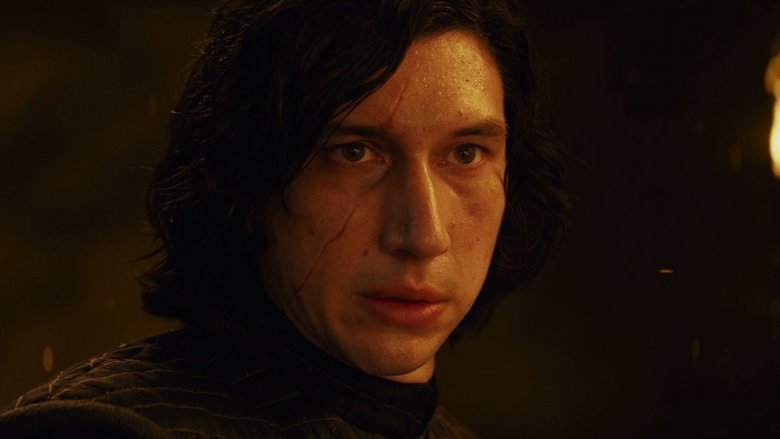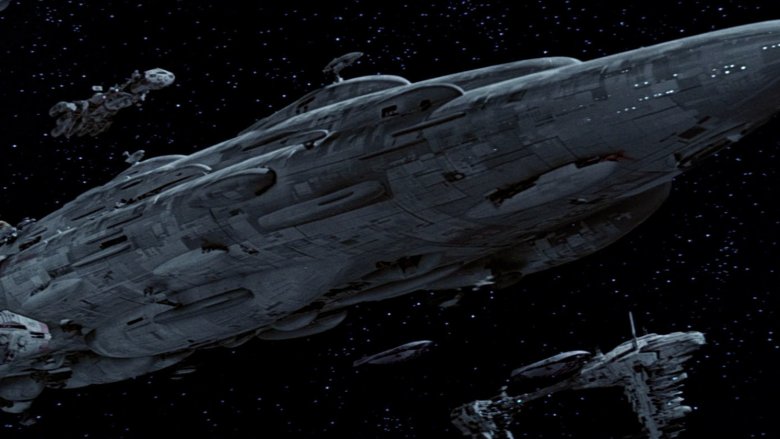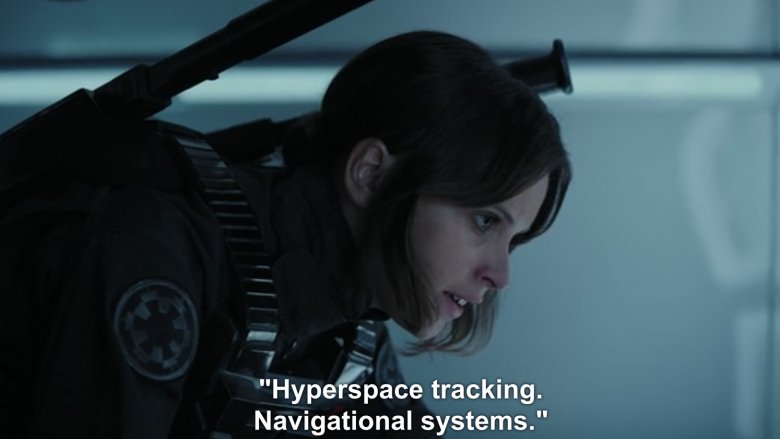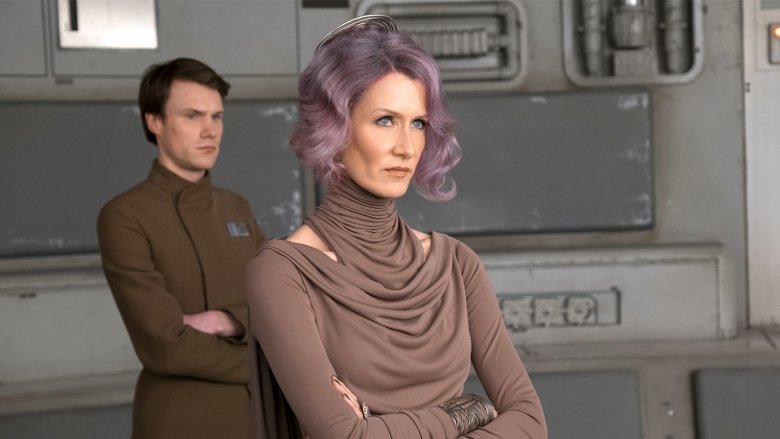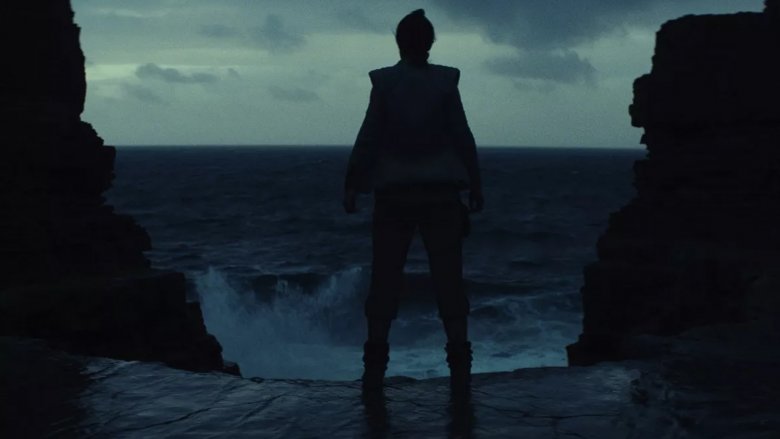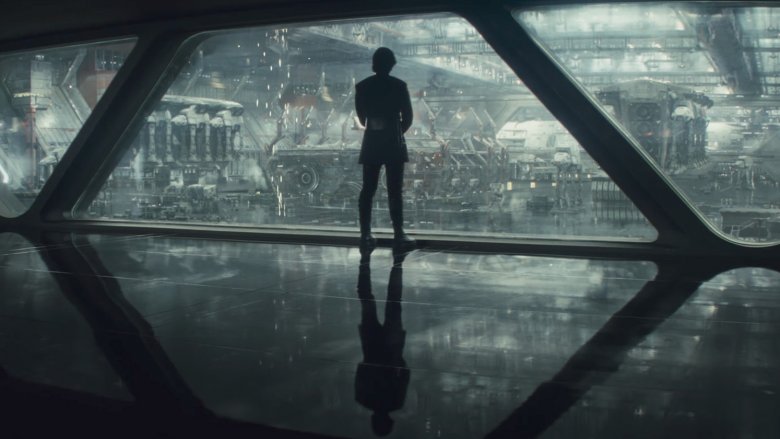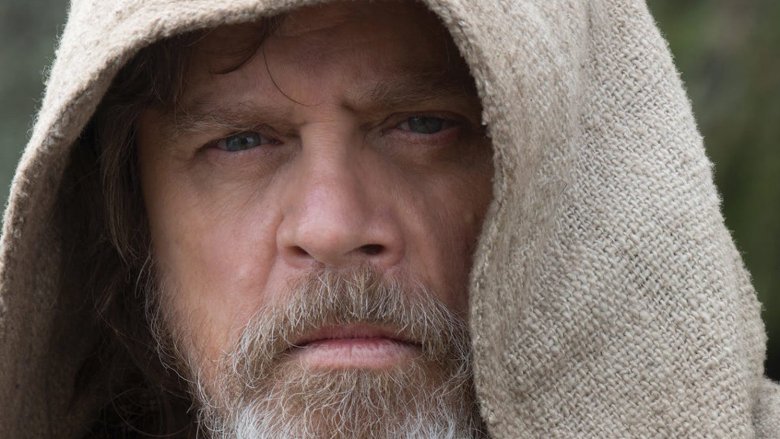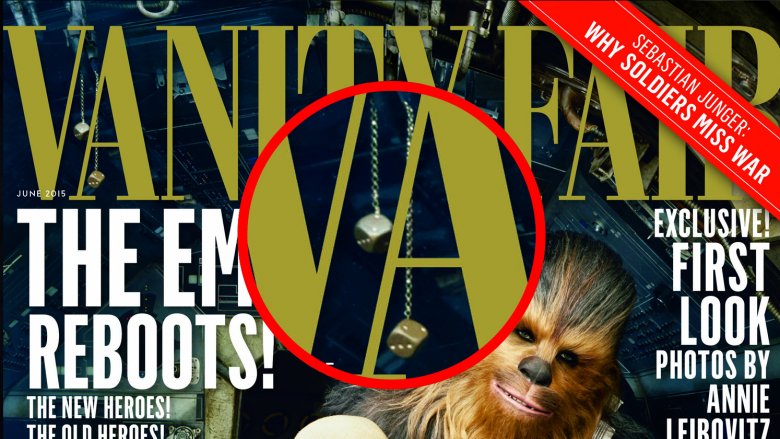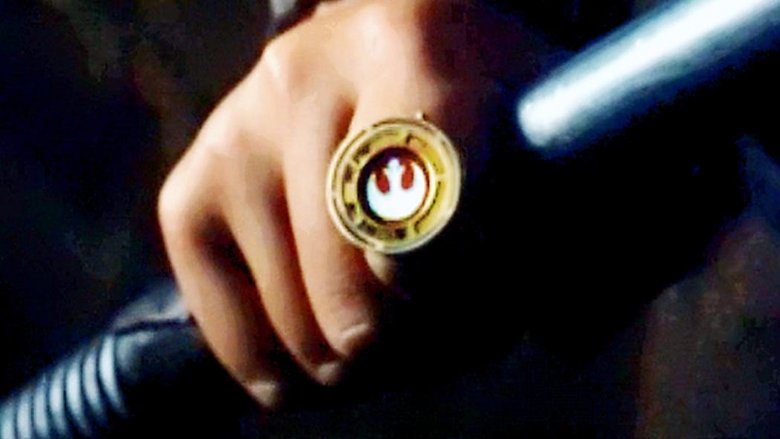The Most Confusing Moments In The Last Jedi Explained
Whether you loved or hated Star Wars: The Last Jedi, you were probably left with some burning questions after the credits rolled. Some parts of the movie's plot were genuinely perplexing from a storytelling standpoint, while other scenes raised some intriguing possibilities for Episode IX and beyond. Let's take a look at some of the most confusing moments from The Last Jedi, to explain just what they meant and their potential implications for the future of Star Wars. Spoilers ahead!
Out of gas
In The Last Jedi, the Resistance fleet is low on fuel with the First Order following them. Can starships really "run out of gas," or was this just a contrivance by director Rian Johnson? Actually, this idea is supported by official Star Wars canon. Hypermatter fuel is created when the core of a planet is exposed to solar radiation. A hyperdrive annihilates hypermatter particles, using the energy to propel the ship into hyperspace. Hyperdrive engines are rated by class according to their speed and efficiency.
Just like nuclear reactors, hyperdrives need to be refueled. In The Phantom Menace, the hyperdrive generator in Padme's ship is damaged, and they're forced to land on Tatooine for repairs and to refuel. A typical starfighter's hyperdrive might use several thousand kilograms of hypermatter per second. The Venator-class Star Destroyers used during the Clone Wars annihilated 40,000 tons of hypermatter per second, and the Resistance flagship Raddus from The Last Jedi was three times that size.
The movie did make one confusing mistake: it's implied that another hyperspace jump would drop their fuel reserves even lower than running at sublight speeds. Actually, starships have separate sublight engines that use different fuel—although they do need refueling, too. Apparently, the Resistance fleet was low on both. So yes, running out of gas is an actual thing in Star Wars—although it could have been explained better in the movie.
Hyperspace tracking
Another confusing aspect of The Last Jedi was the way the First Order managed to track the Resistance fleet through hyperspace—a feat previously thought impossible. In Rogue One, Jyn Erso mentions "Hyperspace Tracking" as one of the projects listed in the Imperial archive on Scarif. This proves the Empire was working on this idea decades before The Last Jedi. Imperial-class Star Destroyers could detect the specialized radiation emitted by a hyperdrive, but in A New Hope, Darth Vader and Grand Moff Tarkin still had to use a homing beacon to track the Millennium Falcon to Yavin IV. The First Order clearly was able to take that budding Imperial technology and create a sensor module that could actively track starships through hyperspace.
According to Rose, all the First Order starships might be equipped with a tracking module, but only the one on the "command" ship would be active. In this case, that was Snoke's dreadnaught, the Supremacy. Rose claimed if they could interfere with the Supremacy's tracker long enough for the Resistance fleet to jump away, they might be able to escape. Because of D.J.'s betrayal, we never got to see if Rose was right. More to the point, could the First Order track the Millennium Falcon as it escaped Crait? One thing's for sure—we're going to need more information in Episode IX to understand the full implications of this new technology.
Amilyn Holdo's silence
One frequently discussed plot point from The Last Jedi involves the conflict between Poe Dameron and Vice Admiral Amilyn Holdo. Some fans don't understand why Holdo didn't just tell Poe her plan. It might look like she's being arrogant, but the truth is more complicated. At the start of the film, Poe ignored Leia's order to retreat. She was forced to send out their bombers and fighters to back him up. As a result, the Resistance suffered huge losses to destroy a single First Order ship.
Later, Holdo ordered Poe to his post and ignored his demands. From a military perspective, her choices makes sense. In Rogue One, Captain Cassian Andor didn't plan strategy—he was expected to follow orders. Holdo didn't need the disobedient and recently-demoted Captain Dameron causing dissent while she made her plans. Also, the Vice Admiral didn't know about the First Order's hyperspace tracker at first, so she may have been worried about a mole. Holdo surely didn't expect Poe to mutiny or to risk the Resistance fleet by sending Rose and Finn on a secret mission. Would Poe have acted differently if he'd known her plans? Maybe, maybe not. Don't forget that Poe actually ignored even General Organa's orders. The overall theme of The Last Jedi is failure and what we learn from it. Poe Dameron made major missteps that got countless people killed, and we can only hope that his failures have made him a better man—and a better leader.
The black hole
One of the most confusing scenes in The Last Jedi happens when Rey visits the cave under the island on Ahch-To. What follows is hands-down the trippiest and most mind-bending scene in the Star Wars franchise. So what is this place and what exactly did Rey's experience there mean? Luke explained that the cave is a place strong in the Dark side—much like the cave he explored on Dagobah. At its essence, the Dark side of the Force is about channeling fear, hate, and anger. These caves sense your deepest fears and use them in a vision that tests your inner strength.
In the cave on Dagobah, Luke angrily confronts Darth Vader and beheads him. But then Vader's mask shatters, revealing Luke's face underneath. Luke's lesson is clear: give into your anger and self-doubt and you risk becoming a Vader yourself. According to Last Jedi writer-director Rian Johnson, Rey's experience was focused on her identity—fears about who she really is and her place is in the world. When Rey asks to see her parents, she's shown silhouettes that just fade and merge into her own endlessly repeating reflection. The cave teaches Rey that her identity comes from within and only she can define that. Kylo later tells Rey that her parents were nobodies that abandoned her, and Rey resists temptation again when she doesn't join him. Rey is in charge of her own destiny, and she doesn't need her parents (or Kylo) to find herself.
Mind meld
One largely unexplored mystery of The Last Jedi involves the mental connection between Kylo Ren and Rey. Later on in the film, Supreme Leader Snoke took credit for facilitating their mind meld. Snoke hoped this connection would bait Rey (and possibly Luke) into coming to "save" Kylo. From the little that we know of Snoke, he was probably telling the truth with this boast. The Supreme Leader is clearly skilled and powerful with mental uses of the Force. He was able to influence Ben Solo from across the galaxy, tempting him with the Dark side. Early in The Last Jedi, Snoke even uses a Force choke on General Hux without being physically present. Given his painfully twisted body, it makes sense that Snoke has focused on honing his mental Force abilities.
The first time it happened, Kylo and Rey could only see each other—not their surroundings. Subsequent "visits" between the two were stronger and clearer. Before Rey left Ahch-To, Luke clearly saw Kylo sitting across from Rey in her hut. While Snoke facilitated this link originally, both Kylo and Rey helped make it stronger over time through their desire to connect. Even though Snoke is dead, the bond between the two remains. They saw each other again as Rey helped the Resistance survivors aboard the Millennium Falcon. It seems very likely the mental link between Rey and Kylo will continue to play a role in Episode IX.
Force projections
The concept of Force projections was a new addition to Star Wars lore from The Last Jedi. While nothing is confirmed, it seems likely the connection between Kylo and Rey was actually some milder form of two-way Force projection. They both unconsciously use the Force to maintain and strengthen that link throughout the movie. Kylo obviously knows something about Force projections—the first time it happened, he told Rey, "you're not doing this—the effort would kill you." Sadly, Kylo was right about this one.
Near the end of the film, Luke entered a deep meditative state and used the Force to project an extremely realistic image of himself across the galaxy. There were a few clues that Luke was not physically present on Crait: he looked younger, his feet made no impression in the ground, and he was carrying Anakin's recently destroyed blue lightsaber. However, Kylo was too blinded by rage to realize the truth. After giving Leia and the others enough time to escape, Luke let go of his projection and returned to his body on Ahch-To. The effort required to create such a powerful Force projection had pushed his body too far. Looking to the horizon as always, Luke passed away and became one with the Force. However, this may not be the end of Luke's tale. As Master Yoda once explained, "Luminous beings are we, not this crude matter."
The golden dice
After learning of Han's death, Luke briefly sneaks aboard the Millennium Falcon. In the cockpit, Luke reaches up and takes a pair of golden dice hanging there. You can actually spot these dice during the famous "that's no moon" scene from A New Hope. Later, Luke gives the dice to Leia when he mysteriously appears on Crait. So what is their significance—beyond being a fun Easter egg for Star Wars fans?
In 2017, Lucasfilm's Pablo Hidalgo told Vanity Fair that these were the dice Han Solo used when he won the Millennium Falcon from Lando Calrissian in a game of "Corellian Spike." Hidalgo's claim is confirmed in The Force Awakens Visual Dictionary. With that kind of legendary history, we can only hope the dice make an appearance in 2018's Solo: A Star Wars Story. They might have a major effect on Kylo Ren leading up to Episode IX, too.
Like Luke himself, the dice Luke gives Leia were just a Force projection. Kylo Ren spots them in the Resistance bunker before they fade away—no doubt bringing back some painful memories of the father he murdered. While stalling Kylo so Leia and the others could escape, Luke also did his best to remind Kylo of Han at every opportunity. Before fading away, Luke even tells Kylo, "see you around, kid." This line not only implies that Luke may be back in Force ghost form, but is also another reminder of Han.
The boy with the broom
While many fans expected The Last Jedi to end with Leia and the others together on the Millennium Falcon, it offered audiences an unexpected coda before the credits rolled. In the film's final scene, we see the slave children from the stables of Canto Bight. One of the children—Temiri Blagg—excitedly tells the other kids about Luke Skywalker's heroic last stand on Crait. After being sent to do his chores, Temiri picks up a broom and indulges in a final bit of imagination by hoisting it to the sky while wearing Rose's Rebel Alliance ring. So what exactly is the significance of this scene?
Late in the film, Poe echoes Amilyn Holdo by telling the other Resistance survivors, "we are the spark that will light the fire that will burn the First Order down." The First Order couldn't snuff out the Resistance. Finn and Rose's mission may have ultimately failed, but they succeeded in sparking hope in the hearts of Temiri and the other slave children. That hope will spread across the galaxy once more. It was so quick you might have missed it, but Temiri used the Force to grab his broom—which looks just like a lightsaber in the movie's final shot. This further signals the "awakening" of the Force. Luke may be dead, but the Force remains. What's more, Temiri is a nobody just like Rey, Finn, and Rose—but even a nobody can have a heroic part to play in the future of the galaxy.
